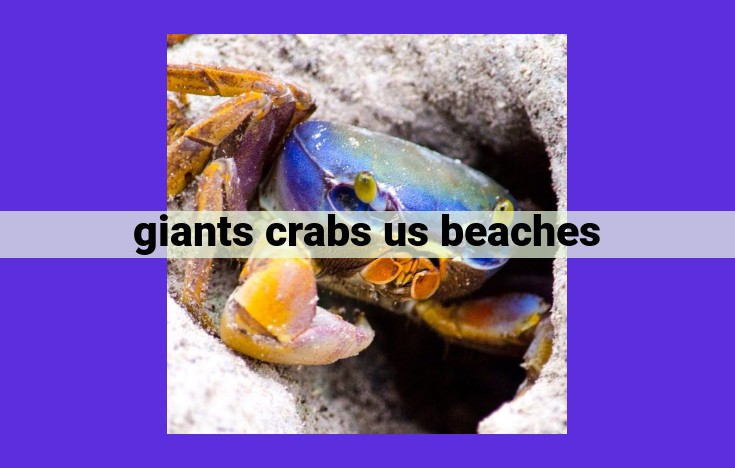Giant Crab Invasion Threatens Us Beaches: Causes, Impacts, And Coexistence Strategies
Giant crabs are increasingly invading US beaches, posing ecological threats and safety concerns. Overfishing, habitat loss, and climate change have contributed to this invasion. Protecting coastal habitats and mitigating habitat loss are crucial for coexistence. Strategies include education, habitat conservation, and coexistence measures. Understanding the causes and impacts of this invasion helps safeguard coastal environments and ensure the sustainability of marine ecosystems and beach communities.
Invasion of Giant Crabs: An Overview
- Discuss the recent increase in giant crab sightings on US beaches.
- Explain the concept of invasive species and their potential threats.
Invasion of Giant Crabs: An Overview
Along the sun-kissed shores of the United States, an ominous phenomenon is unfolding: an invasion of giant crabs. In recent years, sightings of these colossal crustaceans have been on the rise, raising concerns about their impact on our coastal ecosystems and the safety of beachgoers.
The Concept of Invasive Species
Invasive species are non-native organisms that have been introduced to a new environment, where they quickly establish themselves and disrupt the delicate balance of the ecosystem. Giant crabs are a prime example of this, as they have the potential to outcompete native species for food and habitat, leading to a decline in biodiversity. Their sheer size and aggressive nature can also pose a threat to other marine life.
Ecological Impact and Safety Concerns
Impact on Native Species and Ecosystems:
Giant crabs can wreak havoc on native marine life. Their voracious appetites outcompete native species for food resources, including shellfish, fish, and even kelp beds that serve as crucial habitats. This can disrupt marine food webs and lead to the decline of entire populations.
Hazards to Beachgoers and Water Enthusiasts:
While giant crabs typically avoid humans, they can become defensive if provoked. Their powerful claws can inflict serious injuries on beachgoers who inadvertently step on them or attempt to handle them. Giant crabs also pose a threat to water enthusiasts, such as surfers and swimmers, by disturbing their activities and potentially blocking fishing nets.
Best Practices for Safe Interactions:
To minimize risks, follow these best practices when encountering giant crabs:
- Maintain a safe distance and do not approach or touch them.
- Avoid stepping on them or disturbing their burrows.
- If a crab approaches, stay calm and slowly back away.
- If a crab becomes aggressive, do not attempt to engage with it. Instead, leave the area and report the incident to local authorities.
Causes of the Crab Invasion: A Deep Dive into the Factors Triggering the Surge
The recent proliferation of giant crabs on US beaches has raised alarm, and uncovering the underlying causes is crucial for understanding this phenomenon.
Overfishing and Habitat Loss: Disrupting the Natural Balance
Overfishing has depleted the populations of fish that once preyed on crabs, leaving them with fewer natural predators. Furthermore, habitat loss due to coastal development, pollution, and climate change has reduced the availability of food and shelter for native species, making crabs better adapted to disturbed environments.
Climate Change and Warming Ocean Temperatures: Fueling Crab Dominance
Warming ocean temperatures have created more favorable conditions for crabs, as they can tolerate higher temperatures than other marine species. This shift has given them a competitive advantage, allowing them to outcompete native species for resources.
Human activities, such as shipping and boating, can unintentionally transport crabs to new areas, where they may become invasive species. These crabs can disrupt local ecosystems, outcompeting native species and altering the delicate balance of marine communities.
Protecting Coastal Habitats and Mitigating Habitat Loss
The delicate equilibrium of coastal ecosystems faces a formidable threat from the onslaught of giant crabs. Protecting their pristine habitats is crucial for safeguarding native species and ensuring the well-being of these cherished environments.
A delicate balance exists between the need for beach access and the preservation of coastal habitats. Sustainable approaches are essential to strike this balance, allowing humans to enjoy these natural treasures without compromising their ecological integrity.
Mitigating habitat loss is key to promoting coexistence between giant crabs and other marine life. By implementing conservation measures such as habitat restoration, limiting coastal development, and reducing pollution, we can create a more resilient and welcoming environment for both humans and wildlife.
Coexistence and Conservation Strategies
As we seek to balance human activities with the conservation of coastal ecosystems, it is crucial to explore strategies for peaceful coexistence between humans and giant crabs. Understanding their behaviors, habitat preferences, and potential threats can help us develop effective approaches towards harmonizing our presence with theirs.
One key to coexistence is responsible beach etiquette. Avoid disturbing crabs by respecting their space and giving them ample room to move. If you encounter a crab on the beach, calmly walk around it rather than attempting to approach it. When swimming or engaging in water activities, be aware of your surroundings and keep an eye out for crabs to avoid accidental encounters.
Conservation measures are equally vital to safeguarding both giant crabs and the marine ecosystems they inhabit. Protecting coastal habitats is essential for preserving the breeding grounds, nurseries, and food sources that these crabs rely on. We must prioritize measures to reduce overfishing, prevent pollution, and mitigate habitat loss.
Educational outreach and public awareness campaigns play a crucial role in fostering coexistence and conservation. By informing beachgoers about giant crab behaviors, safety precautions, and the importance of their conservation, we can promote responsible behavior and create a sense of stewardship towards these magnificent creatures. Collaboration between scientists, conservationists, and coastal communities is essential for developing and implementing effective coexistence strategies.
Through peaceful coexistence and conservation efforts, we can strive to ensure the sustainability of coastal environments and the well-being of both humans and giant crabs. This delicate balance will require continued research, monitoring, and a commitment from all stakeholders to protect these awe-inspiring creatures and the ecosystems they call home.
